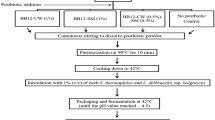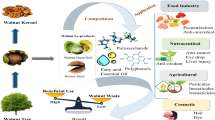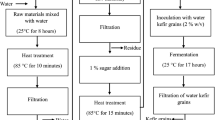Abstract
Brewing with high levels of unmalted oats (Avena sativa) has proven to be successful despite their high contents of β-glucan, protein, and fat. However, little is known about the effect of different oat cultivars on the quality and processability of mashes and worts. Therefore, the aim of this study was to compare the mashing performance of eight oat cultivars, selected because of their low contents of β-glucan, protein, fat, and/or high starch content, when substituting 20 or 40 % barley malt. For this purpose, seven husked (A. sativa L. ‘Lutz’, ‘Buggy’, ‘Galaxy’, ‘Scorpion’, ‘Typhon’, ‘Ivory’, ‘Curly’) and one naked oat cultivar (A. sativa var. nuda ‘NORD 07/711’) were fully characterized using standard methods, Lab-on-a-Chip capillary electrophoresis, and scanning electron microscopy. The rheological behavior of mashes containing up to 40 % of each oat cultivar was measured during mashing by applying a Physica MCR rheometer. In addition, the quality of worts obtained from laboratory-scale mashing trials was analyzed particularly with regard to their cytolytic, proteolytic, and amylolytic properties. The substitution of up to 40 % barley malt with husked or naked oats resulted in significantly higher pH values, β-glucan contents, and viscosities as well as significantly lower soluble nitrogen and polyphenol contents, color values, filtration rates, and apparent attenuation limits. Naked oats contained significantly less β-glucan as well as more protein and starch than the seven husked oat cultivars. The replacement of barley malt with naked oats resulted in a constant extract yield, whereas the use of husked oats caused significant extract losses.








Similar content being viewed by others
References
Welch RW (2011) In: Webster FH, Wood PJ (eds) Oats: chemistry and technology, 2nd edn. AACC International, St. Paul, Minnesota
Wood PJ (2011) In: Webster FH, Wood PJ (eds) Oats: chemistry and technology, 2nd edn. AACC International, St. Paul, Minnesota
Miller SS, Fulcher RG (2011) In: Webster FH, Wood PJ (eds) Oats: chemistry and technology, 2nd edn. AACC International, St. Paul, Minnesota
Salmenkallio-Marttila M, Heiniö R-L, Kaukovirta-Norja A, Poutanen K (2011) In: Webster FH, Wood PJ (eds) Oats: chemistry and technology, 2nd edn. AACC International, St. Paul, Minnesota
Wood PJ, Siddiqui IR, Paton D (1978) Extraction of high-viscosity gums from oats. Cereal Chem 55:1038–1049
Bhatty RS (1992) Total and extractable β-glucan contents of oats and their relationship to viscosity. J Cereal Sci 15:185–192
Beer MU, Wood PJ, Weisz J (1997) Molecular weight distribution and (1 → 3)(1 → 4)-β-D-glucan content of consecutive extracts of various oat and barley cultivars. Cereal Chem 74:476–480
Gajdošová A, Petruláková Z, Havrlentová M, Červená V, Hozová B, Šturdík E, Kogan G (2007) The content of water-soluble and water-insoluble β-D-glucans in selected oats and barley varieties. Carbohydr Polym 70:46–52
Bamforth CW (1985) Biochemical approaches to beer quality. J Inst Brew 91:154–160
Doublier J-L, Wood PJ (1995) Rheological properties of aqueous solutions of (1 → 3)(1 → 4)-β-D-glucan from oats (Avena sativa L.). Cereal Chem 72:335–340
Ajithkumar A, Andersson R, Åman P (2005) Content and molecular weight of extractable β-glucan in American and Swedish oat samples. J Agric Food Chem 53:1205–1209
Letters R (1977) In: Proceedings of the 16th European Brewery Convention Congress, Amsterdam
Morrison WR (1988) Lipids in cereal starches: a review. J Cereal Sci 8:1–15
Lehtinen P, Kaukovirta-Norja A (2011) In: Webster FH, Wood PJ (eds) Oats: chemistry and technology, 2nd edn. AACC International, St. Paul, Minnesota
Paterson A, Swanston JS, Piggott JR (2003) In: Lea AGH, Piggott JR (eds) Fermented beverage production, 2nd edn. Kluwer Academic/Plenum Publishers, New York
Kar A, Jacquier J-C, Morgan DJ, Lyng JG, McKenna BM (2005) Influence of lipid extraction process on the rheological characteristics, swelling power, and granule size of rice starches in excess water. J Agric Food Chem 53:8259–8264
Gibiński M, Palasiński M, Tomasik P (1993) Physicochemical properties of defatted oat starch. Starch/Stärke 45:354–357
Schnitzenbaumer B, Kerpes R, Titze J, Jacob F, Arendt EK (2012) Impact of various levels of unmalted oats (Avena sativa L.) on the quality and processability of mashes, worts, and beers. J Am Soc Brew Chem 70:142–149
Jacob F (ed) (2011) MEBAK Raw materials, collection of brewing analysis methods of the Mitteleuropäische Brautechnische Analysenkommission. Self-published by MEBAK, Freising-Weihenstephan, Germany
Brijs K, Trogh I, Jones BL, Delcour JA (2002) Proteolytic enzymes in germinating rye grains. Cereal Chem 79:423–428
Klose C, Schehl BD, Arendt EK (2009) Fundamental study on protein changes taking place during malting of oats. J Cereal Sci 49:83–91
Oliveira PM, Mauch A, Jacob F, Waters DM, Arendt EK (2012) Fundamental study on the influence of Fusarium infection on quality and ultrastructure of barley malt. Int J Food Microbiol 156:32–43
Schnitzenbaumer B, Arendt EK, Titze J (2013) Statistical comparison of a new rheological method for defining changes in mash consistency during mashing with the established Rapid Visco Analyser. J Cereal Sci 57:39–46
Miedaner H (ed) (2002) Brautechnische Analysenmethoden Band II, Methodensammlung der Mitteleuropäischen Brautechnischen Analysenkommission, 4th edn. Selbstverlag der MEBAK, Freising-Weihenstephan, Germany
Gosset WS (1908) The probable error of a mean. Biometrika 6:1–25
Welch RW, Hayward MV, Jones DIH (1983) The composition of oat husk and its variation due to genetic and other factors. J Sci Food Agric 34:417–426
Grausgruber H, Scheiblauer J, Schönlechner R, Ruckenbauer P, Berghofer E (2004) In: Vollmann J, Grausgruber H, Ruckenbauer P (eds) Genetic variation for plant breeding. Proceedings of the 17th EUCARPIA General Congress. BOKU—University of Natural Resources and Applied Life Sciences, Vienna, Austria
Youngs VL, Püskülcü M, Smith RR (1977) Oat lipids. I. Composition and distribution of lipid components in two oat cultivars. Cereal Chem 54:803–812
Girardet N, Webster FH (2011) In: Webster FH, Wood PJ (eds) Oats: chemistry and technology, 2nd edn. AACC International, St. Paul, Minnesota
Miller SS, Wood PJ, Pietrzak LN, Fulcher RG (1993) Mixed linkage β-glucan, protein content, and kernel weight in Avena species. Cereal Chem 70:231–233
Givens DI, Davies TW, Laverick RM (2004) Effect of variety, nitrogen fertiliser and various agronomic factors on the nutritive value of husked and naked oats grain. Anim Feed Sci Technol 113:169–181
Griffey C, Brooks W, Kurantz M, Thomason W, Taylor F, Obert D, Moreau R, Flores R, Sohn M, Hicks K (2010) Grain composition of Virginia winter barley and implications for use in feed, food, and biofuels production. J Cereal Sci 51:41–49
Briggs DE (1998) Malts and malting. Blackie Academic & Professional, London
Youngs VL (1972) Protein distribution in the oat kernel. Cereal Chem 49:407–411
Delcour JA, Hoseney RC (2010) Principles of cereal science and technology, 3rd edn. AACC International, St. Paul, Minnesota
Sayar S, White PJ (2011) In: Webster FH, Wood PJ (eds) Oats: chemistry and technology, 2nd edn. AACC International, St. Paul, Minnesota
Back W (ed) (2008) Ausgewählte Kapitel der Brauereitechnologie, 2nd edn. Fachverlag Hans Carl, Nürnberg, Germany
Evans DE, Sheehan MC (2002) Don’t be fobbed off: the substance of beer foam—a review. J Am Soc Brew Chem 60:47–57
Evans DE, Hamet MAG (2005) The selection of a dried yeast strain for use in the apparent attenuation limit malt analysis (AAL) procedure. J Inst Brew 111:209–214
Autio K, Myllymäki O, Suortti T, Saastamoinen M, Poutanen K (1992) Physical properties of (1 → 3), (1 → 4)-β-D-glucan preparates isolated from Finnish oat varieties. Food Hydrocoll 5:513–522
Mikyška A, Hrabák M, Hašková D, Šrogl J (2002) The role of malt and hop polyphenols in beer quality, flavour and haze stability. J Inst Brew 108:78–85
Acknowledgments
This study was funded by the InBev-Baillet Latour Fund. The authors would like to thank Steffen Beuch (Nordsaat Saatzucht GmbH, Granskevitz, Germany) for generously providing oat cultivars.
Conflict of interest
None.
Compliance with Ethics Requirements
This article does not contain any studies with human or animal subjects.
Author information
Authors and Affiliations
Corresponding author
Rights and permissions
About this article
Cite this article
Schnitzenbaumer, B., Arendt, E.K. A comparative study of oat (Avena sativa) cultivars as brewing adjuncts. Eur Food Res Technol 236, 1015–1025 (2013). https://doi.org/10.1007/s00217-013-1965-2
Received:
Revised:
Accepted:
Published:
Issue Date:
DOI: https://doi.org/10.1007/s00217-013-1965-2




